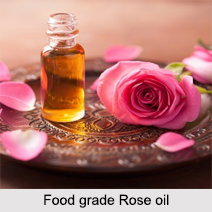 Rose is normally not considered as spice or food flavorant either in national or global situation. Yet, this essential oil is added to many food items for flavoring purposes at least in India. For this reason it has been included as one of the spice. It is basically a thorny shrub. Leaves are serrated and oval. Flowers appear at the end of the stem having a number of petals for which it was known as Satapatri. Size of the flower and aroma often varies according to climate and soil. Fruits are found to be oval, green having a number of seeds. Plants can be propagated both from seeds as well as by planting branches and stems. Better flowers can be produced by second method.
Rose is normally not considered as spice or food flavorant either in national or global situation. Yet, this essential oil is added to many food items for flavoring purposes at least in India. For this reason it has been included as one of the spice. It is basically a thorny shrub. Leaves are serrated and oval. Flowers appear at the end of the stem having a number of petals for which it was known as Satapatri. Size of the flower and aroma often varies according to climate and soil. Fruits are found to be oval, green having a number of seeds. Plants can be propagated both from seeds as well as by planting branches and stems. Better flowers can be produced by second method.
Extraction of Rose Oil
In the first part of the two-stage process of distillation, large stills - traditionally of copper - are filled with roses and water. The still is fired for 60–105 minutes. The vaporized water and rose oil exit the still and enter a condensing apparatus and are then collected in a flask. This distillation yields concentrated oil, direct oil, which makes up about 20% of the final product of the whole process. The water which condenses along with the oil is drained off and redistilled, in order to obtain the water-soluble fractions of the rose oil such as phenethyl alcohol which are a vital component of the aroma and which make up the large bulk, 80%, of the oil. The two oils are combined and make the final rose attar.
In the solvent extraction method, the flowers are agitated in a vat with a solvent such as hexane, which draws out the aroma compounds as well as other soluble substances such as wax and pigments. The extract is subjected to vacuum processing which removes the solvent for re-use. The remaining waxy mass is known as a concrete. The concrete is then mixed with alcohol which dissolves the aromatic constituents, leaving behind the wax and other substances. The alcohol is low-pressure evaporated, leaving behind the finished absolute.
Components in Rose Oil
The flowers of Rosa Damascena Mill contain essential oil, 1% ketone, a bitter principle, 23% tannin, fatty oil and organic acids. The essential oil of this species yields 45.51% centronellol and geraniol. Out of all types of roses the essential oil of this species is supposed to be the best having yield of around 0.05%. The red coloring matter consists of 9 to 10% cyanine, quecitrin and dye stuff.
Pollen from the flower contains 0.76 mg/100 gram of carotene, 1% sugar and 1.5% chlorogenic acid. Rosa centifolia Linn is a weak rose shrub, which does not develop fully. This yields less quantity of buds. Essential oil yield in this variety of rose is 0.011 to 0.43%. Fresh flowers of Rosa Indica Linn yields 0.013 to 0.15% essential oil. Composition of this essential oil is 22.10% stearoptenas, 16.36% phenethyl alcohol, 12.78% geraniol and 23.39% citronellol.
Blending of Rose Oil
Rose oil is used with some particular carrier oils such as jojoba, sweet almond or avocado. Rose blends well with other floral oils, citrus oils, and resin oils, plus many more like Lavender, Clary sage, Roman Chamomile, Sweet orange, Bergamot, Cardamom, Ginger, Frankincense, Lemon, Patchouli, Tangerine etc.
Commercial Use of Rose Oil and Rose Water
Essential oil from Rose has good commercial value. This product has demand as intermediate product as both perfume and flavor. The second way is to follow traditional route of water extraction to produce Rose Water popular in India traditionally used for flavoring food dishes. It is also used medically for washing eyes. Dhaka, now in Bangladesh, Lucknow and Kanauj both in Uttar Pradesh was traditionally known for production of quality Rose Water. The third product of identical in nature is production of Rose Attars, produced by distilling Rose Water.
 Rose Water is added to various sweet dishes like kheer, rabdi, barfi and sandesh. It is also added to rice preparations like Biriyani and fried rice. Rose petals are preserved and added to various sweet dishes too.
Rose Water is added to various sweet dishes like kheer, rabdi, barfi and sandesh. It is also added to rice preparations like Biriyani and fried rice. Rose petals are preserved and added to various sweet dishes too.
Health Benefits of Rose Oil
According to research, the essential oil derived from the rose plant has a wide range of potential benefits. Although a lot of the research to date has been based on small trials, some clear physiological and psychological benefits have emerged.
Rose oil may have stimulated the brain to release endorphins, often called the “feel-good†hormone. Aromatherapy using rose oil could be an effective way to ease pain in patients who"ve had surgery.
When applied directly to the skin, skin care products containing rose essential oil are purported to hydrate dry skin, clear acne, reduce signs of aging, minimize the appearance of scars, and help with conditions such as eczema and rosacea.
A massage with rose oil affects biological factors such as heart rate, stress levels, blood pressure, breathing, and immune function. It is used as a remedy for Anxiety, Depression, Headaches, Menopausal symptoms, Menstrual cramps, Migrain etc.
Rose oil aromatherapy for three subsequent nights had a better quality of sleep compared to those who received routine care
Rose oil is effective against Candida albicans, which can cause fungal infections in the mouth, gut, and vagina
Precautions of using Rose Oil
If someone is going to inhale an essential oil of any kind, place a few drops into a diffuser or sniff the lid of the container instead of putting the nose close to the bottle itself. Inhaling too much may give a headache. Rose oil, like many other essential oils, should not be ingested. Putting essential oil directly on a pet"s coat or skin can be toxic. Person who is allergic to rose or rose oil should definitely avoid. To test the oil, apply a small amount of diluted rose oil (mixed with carrier oil) to the skin on the inside of the elbow. If there is not any itchy, swelling, or redness within a few hours, then it is probably safe to use.




















